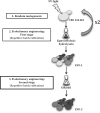Evolutionary engineered Candida intermedia exhibits improved xylose utilization and robustness to lignocellulose-derived inhibitors and ethanol
- PMID: 30498977
- PMCID: PMC6394480
- DOI: 10.1007/s00253-018-9528-x
Evolutionary engineered Candida intermedia exhibits improved xylose utilization and robustness to lignocellulose-derived inhibitors and ethanol
Abstract
The development of robust microorganisms that can efficiently ferment both glucose and xylose represents one of the major challenges in achieving a cost-effective lignocellulosic bioethanol production. Candida intermedia is a non-conventional, xylose-utilizing yeast species with a high-capacity xylose transport system. The natural ability of C. intermedia to produce ethanol from xylose makes it attractive as a non-GMO alternative for lignocellulosic biomass conversion in biorefineries. We have evaluated the fermentation capacity and the tolerance to lignocellulose-derived inhibitors and the end product, ethanol, of the C. intermedia strain CBS 141442 isolated from steam-exploded wheat straw hydrolysate. In a mixed sugar fermentation medium, C. intermedia CBS 141442 co-fermented glucose and xylose, although with a preference for glucose over xylose. The strain was clearly more sensitive to inhibitors and ethanol when consuming xylose than glucose. C. intermedia CBS 141442 was also subjected to evolutionary engineering with the aim of increasing its tolerance to inhibitors and ethanol, and thus improving its fermentation capacity under harsh conditions. The resulting evolved population was able to ferment a 50% (v/v) steam-exploded wheat straw hydrolysate (which was completely inhibitory to the parental strain), improving the sugar consumption and the final ethanol concentration. The evolved population also exhibited a better tolerance to ethanol when growing in a xylose medium supplemented with 35.5 g/L ethanol. These results highlight the potential of C. intermedia CBS 141442 to become a robust yeast for the conversion of lignocellulose to ethanol.
Keywords: Lignocellulosic bioethanol; Microbial robustness; Non-conventional yeast; Xylose fermentation.
Conflict of interest statement
Conflicts of interest
The authors declare that they have no conflict of interest.
Research involving human participants and/or animals
This article does not contain any studies with human participants or animals performed by any of the authors.
Figures





Similar articles
-
Improved ethanol and reduced xylitol production from glucose and xylose mixtures by the mutant strain of Candida shehatae ATCC 22984.Appl Biochem Biotechnol. 2012 Apr;166(7):1781-90. doi: 10.1007/s12010-012-9586-y. Epub 2012 Feb 11. Appl Biochem Biotechnol. 2012. PMID: 22328261
-
Exceptional hexose-fermenting ability of the xylitol-producing yeast Candida guilliermondii FTI 20037.J Biosci Bioeng. 2016 Jun;121(6):631-637. doi: 10.1016/j.jbiosc.2015.10.011. Epub 2015 Nov 18. J Biosci Bioeng. 2016. PMID: 26596373
-
Enhancing xylose-fermentation capacity of engineered Saccharomyces cerevisiae by multistep evolutionary engineering in inhibitor-rich lignocellulose hydrolysate.FEMS Yeast Res. 2024 Jan 9;24:foae013. doi: 10.1093/femsyr/foae013. FEMS Yeast Res. 2024. PMID: 38604750 Free PMC article.
-
Genetic improvement of native xylose-fermenting yeasts for ethanol production.J Ind Microbiol Biotechnol. 2015 Jan;42(1):1-20. doi: 10.1007/s10295-014-1535-z. Epub 2014 Nov 18. J Ind Microbiol Biotechnol. 2015. PMID: 25404205 Review.
-
Current state-of-the-art in ethanol production from lignocellulosic feedstocks.Microbiol Res. 2020 Nov;240:126534. doi: 10.1016/j.micres.2020.126534. Epub 2020 Jun 27. Microbiol Res. 2020. PMID: 32683278 Review.
Cited by
-
Insights into cell robustness against lignocellulosic inhibitors and insoluble solids in bioethanol production processes.Sci Rep. 2022 Jan 11;12(1):557. doi: 10.1038/s41598-021-04554-4. Sci Rep. 2022. PMID: 35017613 Free PMC article.
-
Biovalorisation of crude glycerol and xylose into xylitol by oleaginous yeast Yarrowia lipolytica.Microb Cell Fact. 2020 Jun 3;19(1):121. doi: 10.1186/s12934-020-01378-1. Microb Cell Fact. 2020. PMID: 32493445 Free PMC article.
-
Engineering of sugar transporters for improvement of xylose utilization during high-temperature alcoholic fermentation in Ogataea polymorpha yeast.Microb Cell Fact. 2020 Apr 25;19(1):96. doi: 10.1186/s12934-020-01354-9. Microb Cell Fact. 2020. PMID: 32334587 Free PMC article.
-
Contribution of YPRO15C Overexpression to the Resistance of Saccharomyces cerevisiae BY4742 Strain to Furfural Inhibitor.Pol J Microbiol. 2023 Jun 14;72(2):177-186. doi: 10.33073/pjm-2023-019. eCollection 2023 Jun 1. Pol J Microbiol. 2023. PMID: 37314359 Free PMC article.
-
A unique metabolic gene cluster regulates lactose and galactose metabolism in the yeast Candida intermedia.Appl Environ Microbiol. 2024 Oct 23;90(10):e0113524. doi: 10.1128/aem.01135-24. Epub 2024 Sep 6. Appl Environ Microbiol. 2024. PMID: 39240082 Free PMC article.
References
-
- Alvira P, Tomás-Pejó E, Ballesteros M, Negro MJ. Pretreatment technologies for an efficient bioethanol production process based on enzymatic hydrolysis: a review. Bioresour Technol. 2010;101:4851–4861. - PubMed
-
- Alvira P, Moreno AD, Ibarra D, Sáez F, Ballesteros M. Improving the fermentation performance of Saccharomyces cerevisiae by laccase during ethanol production from steam-exploded wheat straw at high-substrate loadings. Biotechnol Prog. 2013;29:74–82. - PubMed
MeSH terms
Substances
Grants and funding
LinkOut - more resources
Full Text Sources

